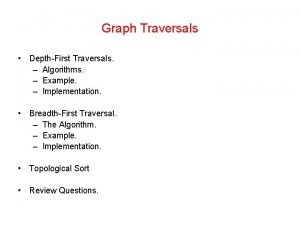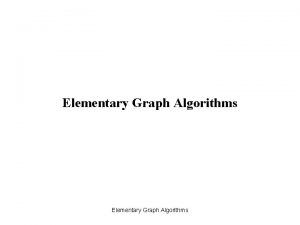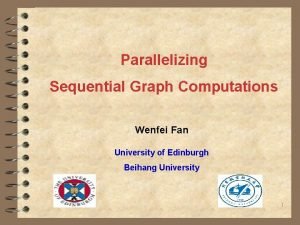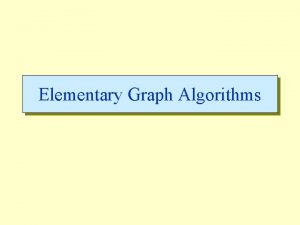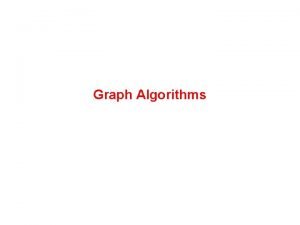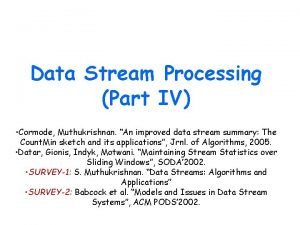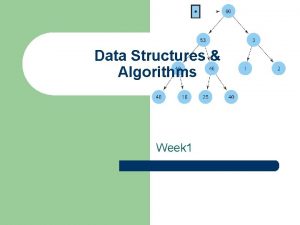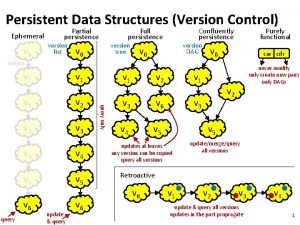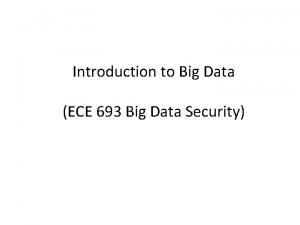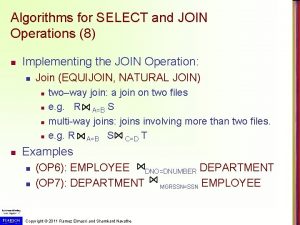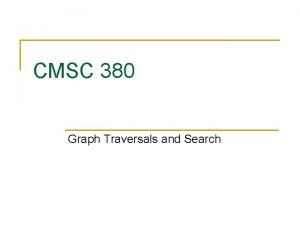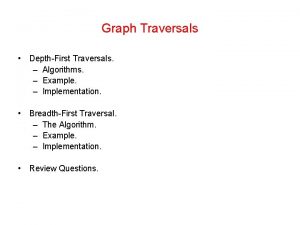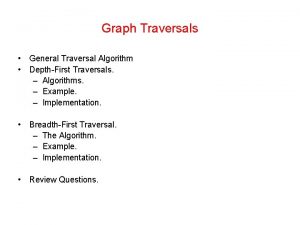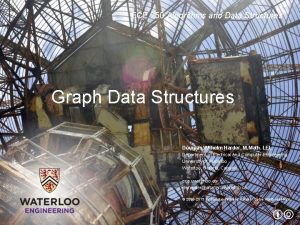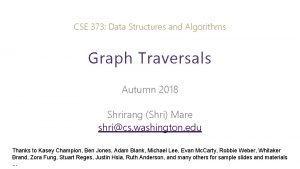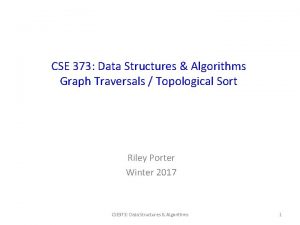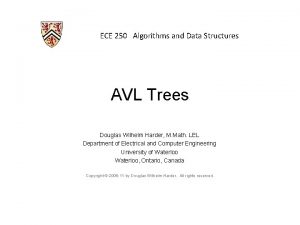ECE 250 Algorithms and Data Structures Graph traversals







































- Slides: 39

ECE 250 Algorithms and Data Structures Graph traversals Douglas Wilhelm Harder, M. Math. LEL Department of Electrical and Computer Engineering University of Waterloo, Ontario, Canada ece. uwaterloo. ca dwharder@alumni. uwaterloo. ca © 2006 -2013 by Douglas Wilhelm Harder. Some rights reserved.

Graph traversals 2 Outline We will look at traversals of graphs – – Breadth-first or depth-first traversals Must avoid cycles Depth-first traversals can be recursive or iterative Problems that can be solved using traversals

Graph traversals 3 Strategies Traversals of graphs are also called searches We can use either breadth-first or depth-first traversals – Breadth-first requires a queue – Depth-first requires a stack We each case, we will have to track which vertices have been visited requiring Q(|V|) memory – One option is a hash table – If we can use a bit array, this requires only |V|/8 bytes The time complexity cannot be better than and should not be worse than Q(|V| + |E|) – Connected graphs simplify this to Q(|E|) – Worst case: Q(|V|2)

Graph traversals 4 Breadth-first traversal Consider implementing a breadth-first traversal on a graph: – Choose any vertex, mark it as visited and push it onto queue – While the queue is not empty: • Pop to top vertex v from the queue • For each vertex adjacent to v that has not been visited: – Mark it visited, and – Push it onto the queue This continues until the queue is empty – Note: if there are no unvisited vertices, the graph is connected,

Graph traversals 5 Iterative depth-first traversal An implementation can use a queue void Graph: : depth_first_traversal( Vertex *first ) const { unordered_map<Vertex *, int> hash; hash. insert( first ); std: : queue<Vertex *> queue; queue. push( first ); while ( !queue. empty() ) { Vertex *v = queue. front(); queue. pop(); // Perform an operation on v for ( Vertex *w : v->adjacent_vertices() ) { if ( !hash. member( w ) ) { hash. insert( w ); queue. push( w ); } }

Graph traversals 6 Breadth-first traversal The size of the queue is O(|V|) – The size depends both on: • The number of edges, and • The out-degree of the vertices

Graph traversals 7 Depth-first traversal Consider implementing a depth-first traversal on a graph: – Choose any vertex, mark it as visited – From that vertex: • If there is another adjacent vertex not yet visited, go to it • Otherwise, go back to the most previous vertex that has not yet had all of its adjacent vertices visited and continue from there – Continue until no visited vertices have unvisited adjacent vertices Two implementations: – Recursive – Iterative

Graph traversals 8 Recursive depth-first traversal A recursive implementation uses the call stack for memory: void Graph: : depth_first_traversal( Vertex *first ) const { std: : unordered_map<Vertex *, int> hash; hash. insert( first ); first->depth_first_traversal( hash ); } void Vertex: : depth_first_traversal( unordered_map<Vertex *, int> &hash ) const { // Perform an operation on this for ( Vertex *v : adjacent_vertices() ) { if ( !hash. member( v ) ) { hash. insert( v ); v->depth_first_traversal( hash ); } } }

Graph traversals 9 Iterative depth-first traversal An iterative implementation can use a stack void Graph: : depth_first_traversal( Vertex *first ) const { unordered_map<Vertex *, int> hash; hash. insert( first ); std: : stack<Vertex *> stack; stack. push( first ); while ( !stack. empty() ) { Vertex *v = stack. top(); stack. pop(); // Perform an operation on v for ( Vertex *w : v->adjacent_vertices() ) { if ( !hash. member( w ) ) { hash. insert( w ); stack. push( w ); } }

Graph traversals 10 Iterative depth-first traversal If memory is an issue, we can reduce the stack size: – For the vertex: • Mark it as visited • Perform an operation on that vertex • Place it onto an empty stack – While the stack is not empty: • If the vertex on the top of the stack has an unvisited adjacent vertex, – Mark it as visited – Perform an operation on that vertex – Place it onto the top of the stack • Otherwise, pop the top of the stack

Graph traversals 11 Standard Template Library (STL) approach An object-oriented STL approach would be create a iterator class: – The hash table and stack/queue are private member variables created in the constructor – Internally, it would store the current node – The auto-increment operator would pop the top of the stack and place any unvisited adjacent vertices onto the stack/queue – The auto-decrement operator would not be implemented • You can’t go back…

Graph traversals 12 Example Consider this graph

Graph traversals 13 Example Performing a breadth-first traversal – Push the first vertex onto the queue A

Graph traversals 14 Example Performing a breadth-first traversal – Pop A and push B, C and E A B C E

Graph traversals 15 Example Performing a breadth-first traversal: – Pop B and push D A, B C E D

Graph traversals 16 Example Performing a breadth-first traversal: – Pop C and push F A, B, C E D F

Graph traversals 17 Example Performing a breadth-first traversal: – Pop E and push G and H A, B, C, E D F G H

Graph traversals 18 Example Performing a breadth-first traversal: – Pop D A, B, C, E, D F G H

Graph traversals 19 Example Performing a breadth-first traversal: – Pop F A, B, C, E, D, F G H

Graph traversals 20 Example Performing a breadth-first traversal: – Pop G and push I A, B, C, E, D, F, G H I

Graph traversals 21 Example Performing a breadth-first traversal: – Pop H A, B, C, E, D, F, G, H I

Graph traversals 22 Example Performing a breadth-first traversal: – Pop I A, B, C, E, D, F, G, H, I

Graph traversals 23 Example Performing a breadth-first traversal: – The queue is empty: we are finished A, B, C, E, D, F, G, H, I

Graph traversals 24 Example Perform a recursive depth-first traversal on this same graph

Graph traversals 25 Example Performing a recursive depth-first traversal: – Visit the first node A

Graph traversals 26 Example Performing a recursive depth-first traversal: – A has an unvisited neighbor A, B

Graph traversals 27 Example Performing a recursive depth-first traversal: – B has an unvisited neighbor A, B, C

Graph traversals 28 Example Performing a recursive depth-first traversal: – C has an unvisited neighbor A, B, C, D

Graph traversals 29 Example Performing a recursive depth-first traversal: – D has no unvisited neighbors, so we return to C A, B, C, D, E

Graph traversals 30 Example Performing a recursive depth-first traversal: – E has an unvisited neighbor A, B, C, D, E, G

Graph traversals 31 Example Performing a recursive depth-first traversal: – F has an unvisited neighbor A, B, C, D, E, G, I

Graph traversals 32 Example Performing a recursive depth-first traversal: – H has an unvisited neighbor A, B, C, D, E, G, I, H

Graph traversals 33 Example Performing a recursive depth-first traversal: – We recurse back to C which has an unvisited neighbour A, B, C, D, E, G, I, H, F

Graph traversals 34 Example Performing a recursive depth-first traversal: – We recurse finding that no other nodes have unvisited neighbours A, B, C, D, E, G, I, H, F

Graph traversals 35 Comparison Performing a recursive depth-first traversal: – We recurse finding that no other nodes have unvisited neighbours A, B, C, D, E, G, I, H, F

Graph traversals 36 Comparison The order in which vertices can differ greatly – An iterative depth-first traversal may also be different again A, B, C, E, D, F, G, H, I A, B, C, D, E, G, I, H, F

Graph traversals 37 Applications of tree traversals include: – – – Determining connectiveness and finding connected sub-graphs Determining the path length from one vertex to all others Testing if a graph is bipartite Determining maximum flow Cheney’s algorithm for garbage collection

Graph traversals 38 Summary This topic covered graph traversals – – – Considered breadth-first and depth-first traversals Depth-first traversals can recursive or iterative More overhead than traversals of rooted trees Considered a STL approach to the design Considered an example with both implementations They are also called searches

Graph traversals 39 References Wikipedia, http: //en. wikipedia. org/wiki/Graph_traversal http: //en. wikipedia. org/wiki/Depth-first_search http: //en. wikipedia. org/wiki/Breadth-first_search These slides are provided for the ECE 250 Algorithms and Data Structures course. The material in it reflects Douglas W. Harder’s best judgment in light of the information available to him at the time of preparation. Any reliance on these course slides by any party for any other purpose are the responsibility of such parties. Douglas W. Harder accepts no responsibility for damages, if any, suffered by any party as a result of decisions made or actions based on these course slides for any other purpose than that for which it was intended.
 Ajit diwan iit bombay
Ajit diwan iit bombay Princeton data structures and algorithms
Princeton data structures and algorithms Data structures and algorithms tutorial
Data structures and algorithms tutorial Information retrieval data structures and algorithms
Information retrieval data structures and algorithms Data structures and algorithms bits pilani
Data structures and algorithms bits pilani Data structures and algorithms iit bombay
Data structures and algorithms iit bombay Data structures and algorithms
Data structures and algorithms Data structures and algorithms
Data structures and algorithms Ian munro waterloo
Ian munro waterloo Signature file structure in information retrieval system
Signature file structure in information retrieval system Data structures and algorithms
Data structures and algorithms Depth first traversals
Depth first traversals Algorithms + data structures = programs
Algorithms + data structures = programs Ece 250
Ece 250 Ece 250
Ece 250 Ece 250
Ece 250 Ece 250
Ece 250 Homologous structures definition
Homologous structures definition Euler circuit
Euler circuit White path theorem
White path theorem Parallelizing sequential graph computations
Parallelizing sequential graph computations W graph
W graph Undirected graph algorithms
Undirected graph algorithms Data stream
Data stream Resource allocation graph and wait for graph
Resource allocation graph and wait for graph Explain conditional macro expansion with example
Explain conditional macro expansion with example Assembler data structures
Assembler data structures Data structures and abstractions with java
Data structures and abstractions with java Adts, data structures, and problem solving with c++
Adts, data structures, and problem solving with c++ Data structures and algorithm
Data structures and algorithm Ephemeral data structure
Ephemeral data structure Bridge graph
Bridge graph Qliqview
Qliqview Computational thinking algorithms and programming
Computational thinking algorithms and programming Design and analysis of algorithms syllabus
Design and analysis of algorithms syllabus Association analysis: basic concepts and algorithms
Association analysis: basic concepts and algorithms Fftooo
Fftooo Algorithms for select and join operations
Algorithms for select and join operations Algorithms and flowcharts
Algorithms and flowcharts Undecidable problems and unreasonable time algorithms.
Undecidable problems and unreasonable time algorithms.











